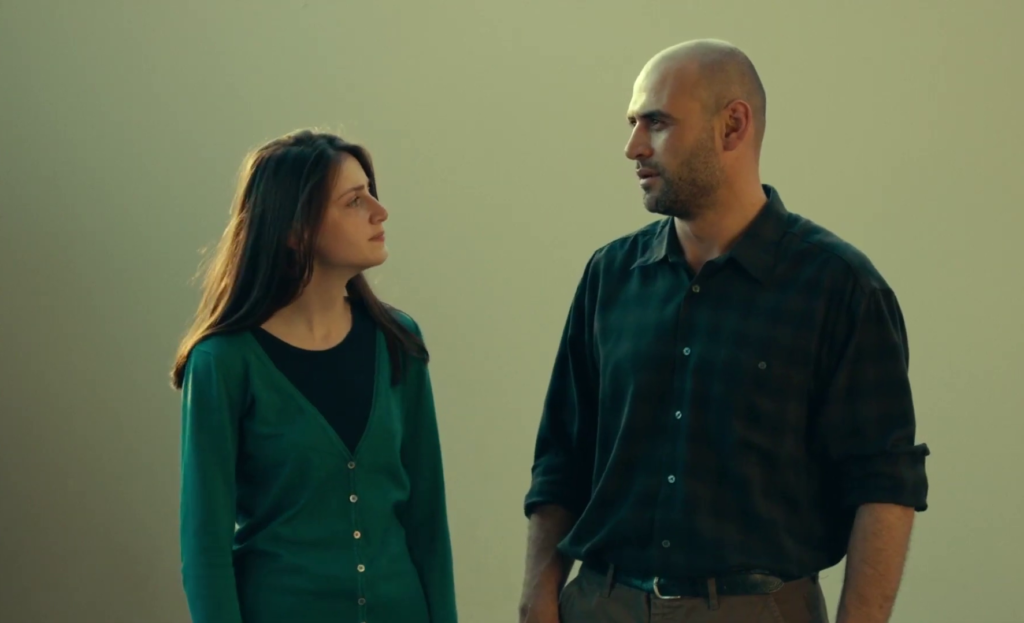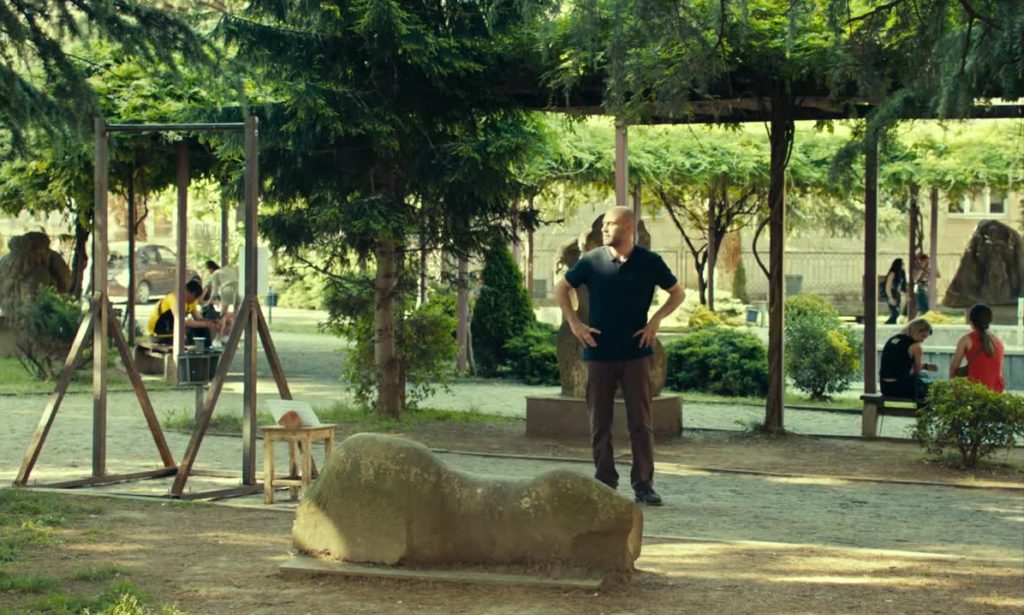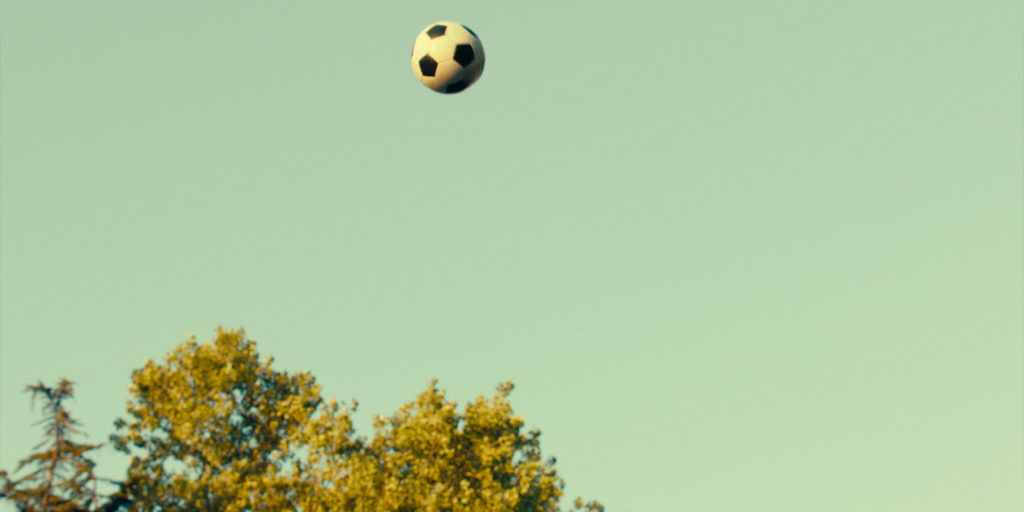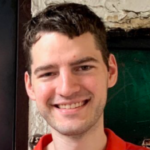
Alexandre Koberidze is a Georgian filmmaker whose second feature, What Do We See When We Look at the Sky? (2021), follows a pair of fated lovers in Kutaisi who are afflicted by a curse that alters their appearances, making them unable to recognize each other.
Koberidze and I spoke following the film’s screening at the 2021 New York Film Festival. This transcript has been edited for length and clarity.
The film made me think of silent-era city symphony films. Were those on your mind?
I don’t quite know when or why or how that started. My previous film I made in Tbilisi [Let the Summer Never Come Again, 2017] somehow also became a film like this. I think one of the reasons is that I lived almost 12 years partly in Berlin. With these films I was coming home, discovering and understanding these places again. Tbilisi was my hometown, but with this one I had a different intention. I wanted to make the film in mostly one location near this bridge and the café, with these two people. But after a few months the film started to change. It was hard to deny that I wanted more from the city, so at some point we did that.
So you wrote a narrative and built the city symphony, the environment, and the sports elements around it? Or did you have some of that you wanted to address, and then you fit it into a narrative?
The main idea was something you could say in a few sentences, but in the script I left some space free because I knew some things would change. But there are also things that were never in the script. The whole thing with the music school, for instance. We went to this music school and immediately knew we wanted to shoot there and started to think about what could happen there. I connected this music school and this way of trying to deal with the curse. Many other places in the film also came about like this.
You have said you wish you started the movie with the image of a step, which is how you originally wrote it. Why did you change it, and why do you wish you hadn’t?
I changed it because we were looking for days for the right step, but somehow in the end I still wasn’t a fan of any of them. One of my most beloved directors, Aleksandre Rekhviashvili, one of his most famous films is called The Step (1985). It would have been an homage to start with the step because he was a big influence on this film.
Talk a little more about that influence.
Formally there are not many similarities. For me it’s more the way he lived and how he was making films. His dignity and sincerity, they’re overwhelming for me. But formally, his films are unique; it would be senseless to repeat something.

Was the voiceover in your film something that you always planned?
The voiceover was there, as in all the films I’ve made before, but there was not as much. Then, while editing, I understood it needed more. I started to take dialogue away, but I didn’t want to take it from the actors so I took it from my father and mother, who play the director and cameraman characters. They don’t have careers as actors so it’s okay. I could take words from them and give them to this storyteller.
Why did you need a storyteller?
There are different reasons. On the one hand it’s just comfortable for the plot, because it’s hard and less interesting to write or shoot scenes that are there just to convey information. It was easier to set it up quickly and give information with a storyteller so I could do the things I wanted to do.
But on the other hand, this storyteller comes along and takes his time telling us stories about the city or about some characters. That’s also vital for the fairytale sensibility of the film, at some point it is clear he’s telling us a fairytale. Then there are very personal parts, where I speak for myself about things I wanted to talk about which maybe are not directly related to the story but are a few sentences I wanted to say.
Shifting gears, you shot partially on 16mm and partially digitally. How did that happen?
Our plan was to shoot on a modern, bigger, high-resolution camera. But for me and the cinematographer it’s kind of problematic. We still don’t know how to deal with those images. We thought about starting with low resolution cameras and moving up, making the change visible. But the cinematographer proposed that we play with analog and digital. So we made the part before the curse 16mm, which is maybe not the most smart or complex thing, but it has this symbolism.
Right as the curse takes effect and you switch to digital, you use text to tell the audience to close their eyes just as the character goes to sleep, with a sound cue. Where did that playfulness come from?
That’s from silent films. The beginnings of cinema had so much playfulness. They had fun looking for ideas and thinking about what cinema is. Today cinema is quite a narrow thing. We say “this is cinema,” and if something is different it’s “arthouse,” and if it’s very different it’s “experimental cinema,” and then “this guy is crazy”—stuff like that. We’re dividing a medium we know can do so many things. It’s so strange. So we said, “let’s be kids and let’s play with it, let’s have fun.”

How does the culture of Georgia, especially poetry and folklore, factor into the film?
This film, like the previous one, is a way of going back, of living in Georgia and understanding it as home. I tried to read and watch more things from Georgia. I’m 36 now. I try to understand who I am, how I think, how things are, and I see myself quite connected to Georgia, but also with the village my great-grandparents come from. I visited this place two or three years ago for the first time and I discovered so many similarities with people who live there. I learned many things about myself. Poetry is part of life, of understanding and seeing life. But it was also a way to get deeper into Kutaisi because it’s not my hometown. To read the writers from there and write about it is part of the work of the film.
You’re clearly a big football fan. How is football similar to cinema?
I see both things as something I can play, as a kind of game. But most interesting for me is that with both cinema and football, it’s about the rhythm. If you watch football, or if you watch a lot of sports generally, it’s so much about the rhythm. Sometimes you have a feeling that a player has become part of some bigger rhythm and done something he will never be able to repeat because he’s in this rhythm other people are not part of. It’s very short moments when some people get into this rhythm and they can do something, but then they’re out.
Cinema is similar. I try to catch this rhythm. It’s milliseconds or seconds sometimes, but if you have it then something can happen.
What Do We See When We Look at the Sky? is streaming with subscription at MUBI.com.
Forrest Cardamenis is a film critic based in Astoria, New York whose writing has also appeared in Reverse Shot, MUBI, and Filmmaker Magazine, among other publications.

